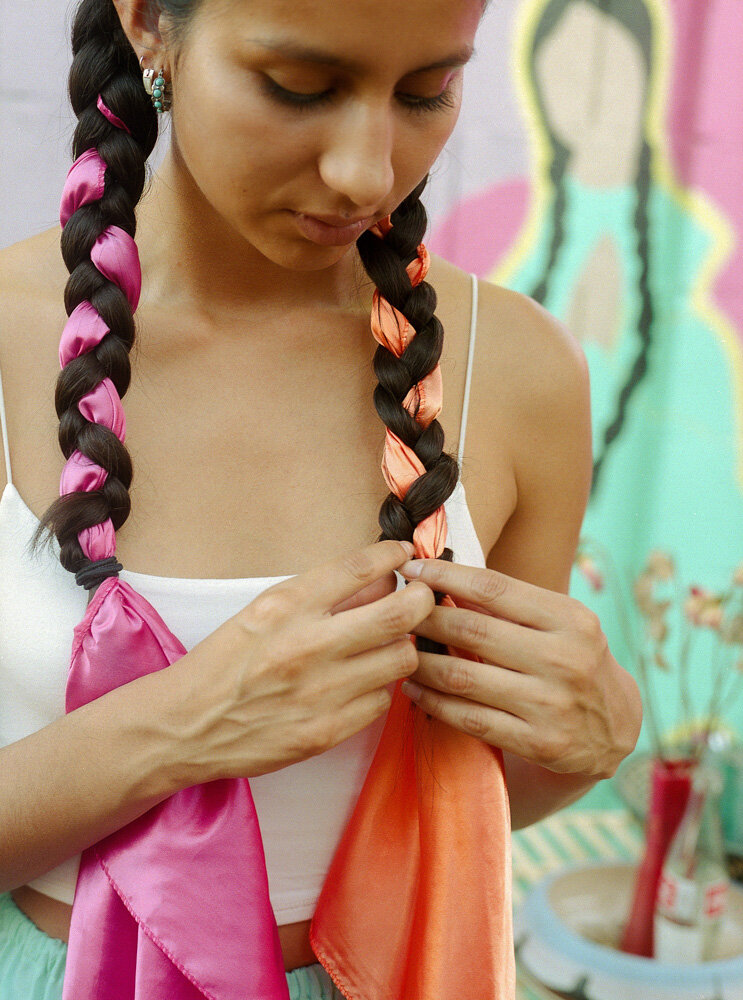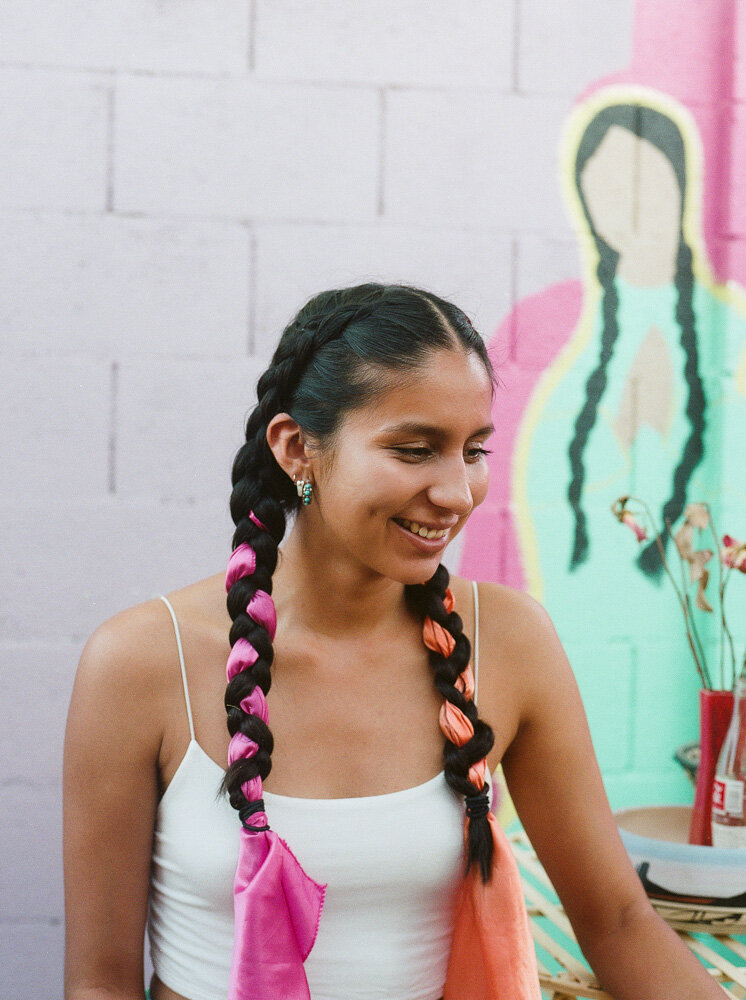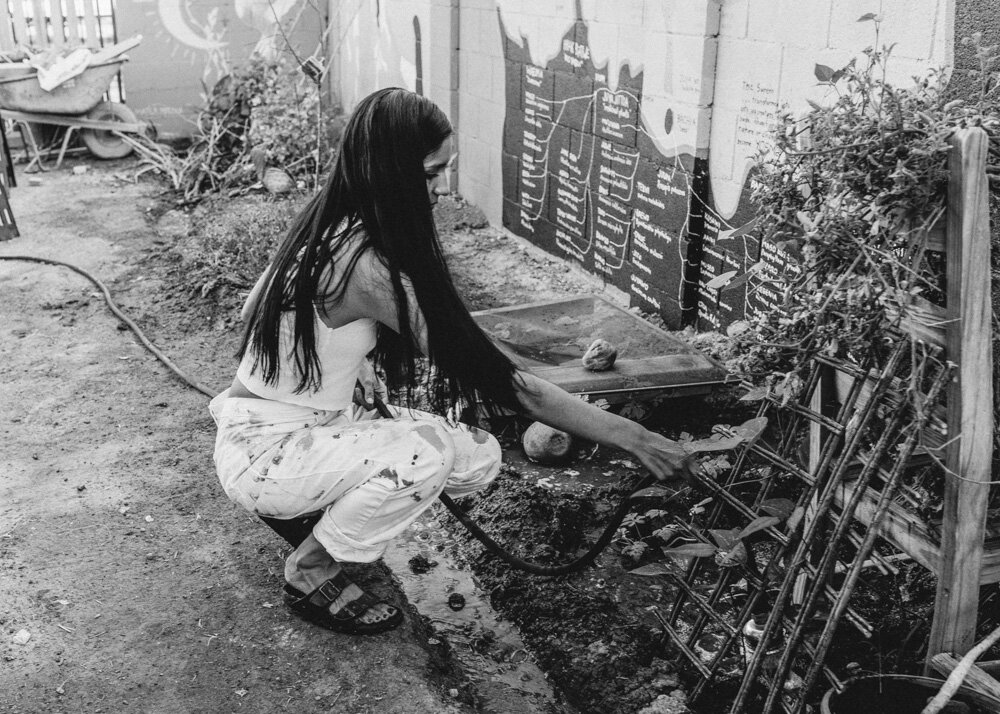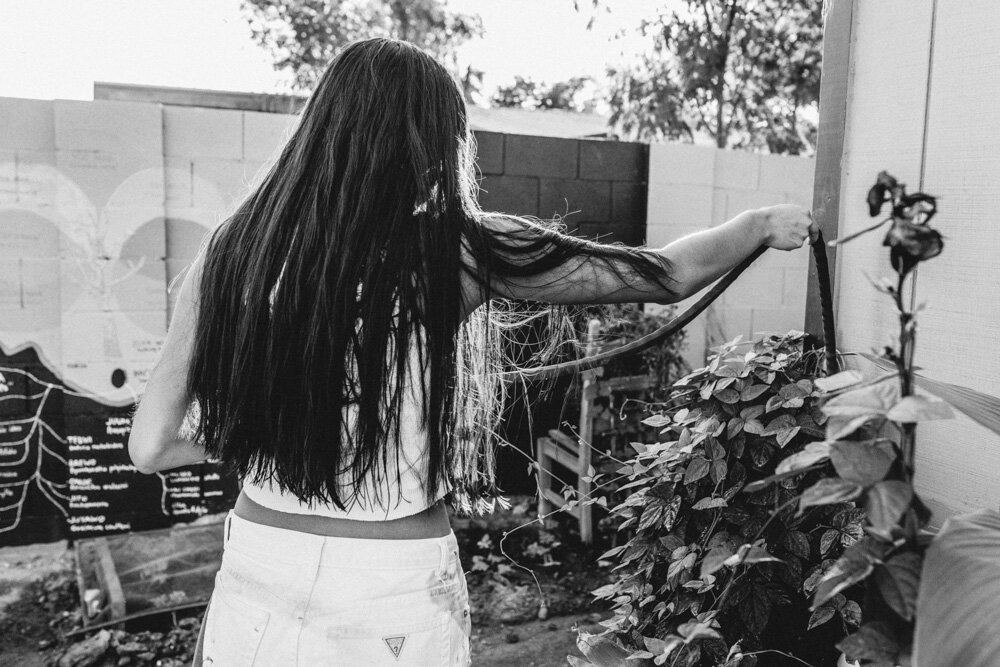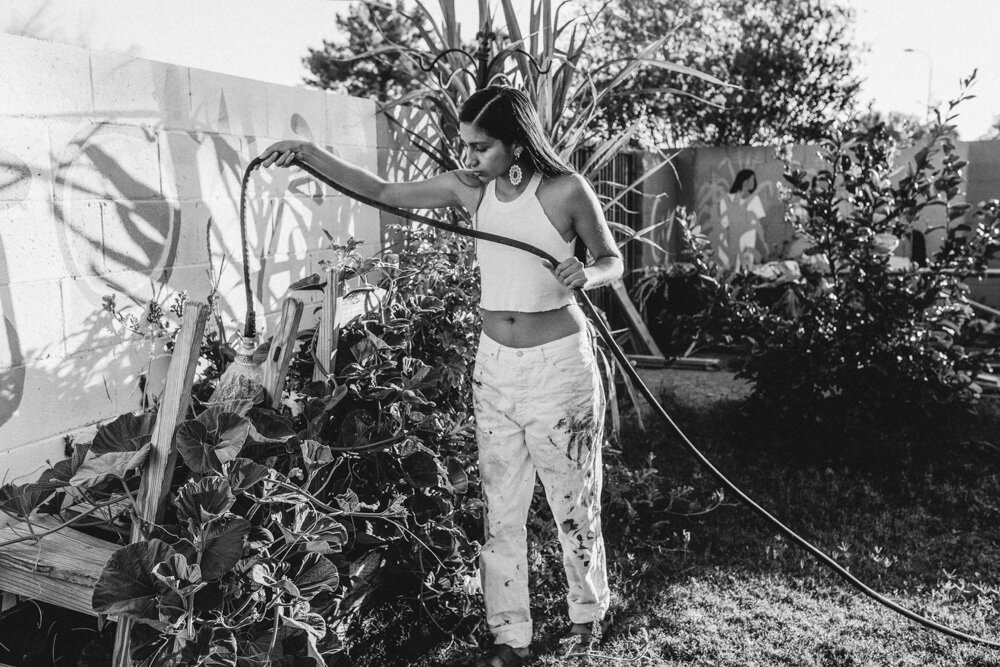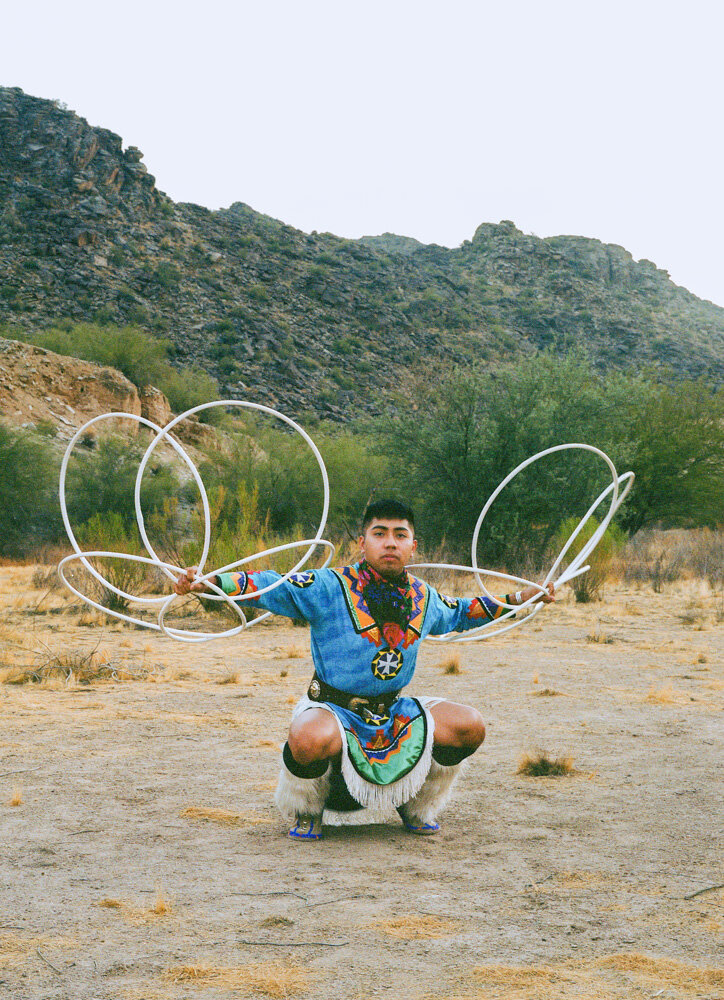Megan Baker - Of the Land
Of the Land is a dual part series by Megan Baker, which celebrates the Indigenous ancestors and Yaqui heritage of her best friend Selina Martinez, as well as the personal strength she cultivates through her connection to nature and elemental balance. The first set of images intimately focuses on Selina, and the duality of her spirit as she maintains connections to her roots, while at once being one of the first modern architects of her tribe. Here, Megan captures her radiating force– a life forged from abundance and love. The second set of images zooms out to highlight the diversity of Indigenous heritage within Arizona through images of a new generation of Powwow dancers within the city.
Through a series of emails, Selina, Megan and I discuss the effects of covid-19 on Indigenous communities, their evolving friendship, and the photographic power of storytelling. Continue reading below for the full interview and series!
- Alexa Fahlman
Across North America, Indigenous communities, and more generally, communities of colour, have been disproportionately impacted by the pandemic. The system of colonialism in both Canada and the United States has created and sustained risk factors for poor health in Indigenous communities. As many Indigenous communities have been removed from their lands and confined to reservations, they lack access to healthcare, essential services, and key preventive measures such as sanitation, clean water and disinfectant. Moreover, even if Indigenous peoples are able to access healthcare services, they often face stigma and discrimination.
Such effects are felt in the town of Guadalupe, an urban Yaqui community in Arizona, that Selina is closely associated to, and where many of her family members live. Back in June, Guadalupe became a hotspot for cases. Selina tells me that, “significant factors for the fast spread were multigenerational households, residents working service oriented jobs, along with residents who may have already been dealing with existing health issues.” Stopping traditional lifestyles such as gathering often, and spending time with family has proven to be extremely difficult for many families.
For Selina, this newfound layer of tension on her current reality has been difficult as even the most trivial tasks have felt challenging due to navigating herself and her community’s safety in uncertain situations. With that said, it has also functioned to bring clarity to the importance of both physical and mental holistic wellbeing. Selina expresses, how “finding positive outlets to channel these tensions has become vital to transforming the weight this moment carries,” she continues, “turning my backyard into a sanctuary through gardens and murals has been one process that has helped filter some of that energy into productive beauty.”
Megan, like Selina, has also felt the strain of the pandemic. As a photographer who leans towards portraiture, the pandemic initially disrupted Megan’s practice, yet she took advantage of this moment to refocus and experiment with new mediums and concepts. Beyond work, she writes “this has also been a year of so many lessons and personal growth - with an emphasis on slowing down, taking care of myself, and allowing myself to simply exist rather than always working on something; which I’ve found has allowed me to give more of myself to the projects I do take on.”
The two best friends met during undergrad of Architecture school at ASU. They both recalled the natural ease of their relationship, what Selina calls “the kind of relationship you don’t have to work at.” At the time, Megan tells me that she had just picked up photography and was looking for a subject for portraiture:
MB: Actually I don’t think Selina knows this but I used to be so intimidated by her, she seemed so cool from afar and, well, I’m not the best at first introductions so I never tried to instigate a friendship until I started photography, then, during this group project we were both on I had this wild dream where she and I were best friends but like 40 years in the future, honestly it was wild but after that I felt like I already knew her so reaching out wasn't intimidating anymore and we just clicked, it’s never felt forced or unnatural - I don’t think we’ve ever even like bickered. Our friendship has really grown over the years and I think we’ve both seen one another grow immensely and like Selina said we balance one another out - where I lack she has abundance to share and vice versa.
Although Selina and Megan are now living in different cities, they continue to push one another to evolve into their best selves through weekly catchups and conversations. It’s this space of love cultivated by the two best friends, that became the initial inspiration for Megan’s photographic series. Having witnessed Selina’s “constant balance with her surroundings and her energy; giving herself unconditionally with such an unwavering, and divinely feminine energy,” Megan knew that this needed to be captured and celebrated. Selina continues, “Obviously it is an honour for Megan to select me as the subject for this project, but to be honest the ease of the production of this series is expressed through the genuine and holistic nature of the photos.”
Indeed, there was no specific process to the series. Megan tells me that it was instead “taking the energy from our shared conversations over the years and trying to translate them through the lens.” Photography was the perfect medium to celebrate the colours which shape Selina’s identity; whether that be the colours of her traditional clothing or her essence itself. Megan took to various mediums of photography– tintypes, black and white, 120mm, and 35mm– to highlight the different attributes of Selina’s identity. Each medium was unique in capturing Selina’s ancestral connections, her design work, and her identity as an upcoming modern woman. For instance, the first set of images from the dual part series pays homage to the duality of Selina’s spirit. Here, her hair intertwined with coloured ribbons, is symbolic of both her heritage and the bond of her dual spirit as both Yoeme and Xicana. Born and raised in Phoenix, Arizona, Selina regards herself as a proud Phoenecian of the Sonoran Desert. Her Yaqui (Yoeme) identity, Selina explains, is varied on a multiplicity of levels, but the root of what she believes it means to be Indigenous is a balanced reciprocal relationship to nature and community:
SM: Previously, my views were skewed by what I was conditioned to believe my tribe was all about. As an urban Yaqui my family has always been active in attending ceremonies within the community but I did not have the context of how our history and past constructed that present reality. Understanding where my ancestors actually originated, visiting our homelands, and centering our emergence story as key aspects to understanding the ancestrality of our tribe. And now moving forward into how we protect our traditions but evolve our identity into the future towards more resilient communities that reflect these varied narratives of what it means to be Yoeme.
When asked if there were ever moments where they felt like they were actively working against harmful, historical depictions of Indigenous communities, Selina confronts the inevitable part of Indigenous history as one of genocide and attempted eradication. Yet, her answer carries resilience, “but we are still here and people forget that or don’t consider us: we are often romanticized and fetishized and our narratives within history books have been written for us, not by us, if they even exist at all.” However, this collaboration between herself and Megan, came from a genuine space of reciprocity and respect. She writes, “it has been a mutually beneficial and balanced exchange of creative energy. And for me this is one way diverse mindsets and communities can find common ground to collaborate towards more enlightened productions of indigenous narratives.”
Thus, in creating a series out of a space of love, Selina and Megan have only grown this space, and continue to spread it within their own communities, both creatively and personally:
SM: What this project has done for me is provide a raw reflection of myself. I see my ancestors in my appearance and I am proud. In my eyes I see my nieces and nephews, our next generation, and I am reminded of why the work I do and create is valuable and should be done with intention. And honestly just hyped to contribute my narrative to the larger feed of indigneous representation. Community and family are one of the same for me and I feel empowered to give back and support the communities that supported me throughout my life journey. Hence why I have chosen to root my work in a place where those relations are already active and expanding. My skillset as an architectural designer sometimes makes me feel like a unicorn and is one of the reasons why I co-created a program called Design Empowerment PHX to facilitate a pathway for the next generation to gain access to design tools and resources towards ‘design enlightenment’. Ideally the return is seeing more people of color in the design industry and academia that visibly amplifies those narratives which are historically undervalued by the dominant society.
MB: I think this has really shown me what I love about photography and art. Past flashy clothes and trendy tones it has the ability to connect people to something much vaster than in the 3-D. Imagery, whether created through camera, paint, or song allows us all to connect to the human condition in a way that nothing else can, and this project helped me remember that. I was born in Denver, CO and raised in Seattle, WA before moving to Phoenix and going to undergrad in AZ. Now I’m in Austin, Texas - I originally moved here for my master’s degree but fell in love with the city and specifically the creative community here. It really is a different experience to any other community I’ve been a part of so I decided to stay after graduating. I could talk for days about my artistic endeavours but I guess I’d say I’m currently working on creating space in Austin for everyone to flourish and remove the gatekeeping systems that halt our cities communal growth. I hope for it to set a precedent for future creative communities everywhere.
Going into the future, we talk briefly of ways in which we can continue to uplift BIPOC communities. Selina reminds us to “become more aware of the preconceived notions we bring to conversations and make intention to approach collaborations from a place of humility and reciprocity.” While Megan notes that in order to support BIPOC communities, “we must continue to listen without ego; to truly hear what they have to say, take action to make sure others hear them as well, and see through the changes asked of us”.
From the outset, a glimpse of any photograph from this series could tell you that Of the Land is a celebration of uniquely individual stories– that much is certain. Yet, having spoken to Megan and Selina, this series reaches far beyond its original intention, existing equally as a beautiful celebration of their friendship, respect for one another, and their inspiring ability to tell the story of it all.


